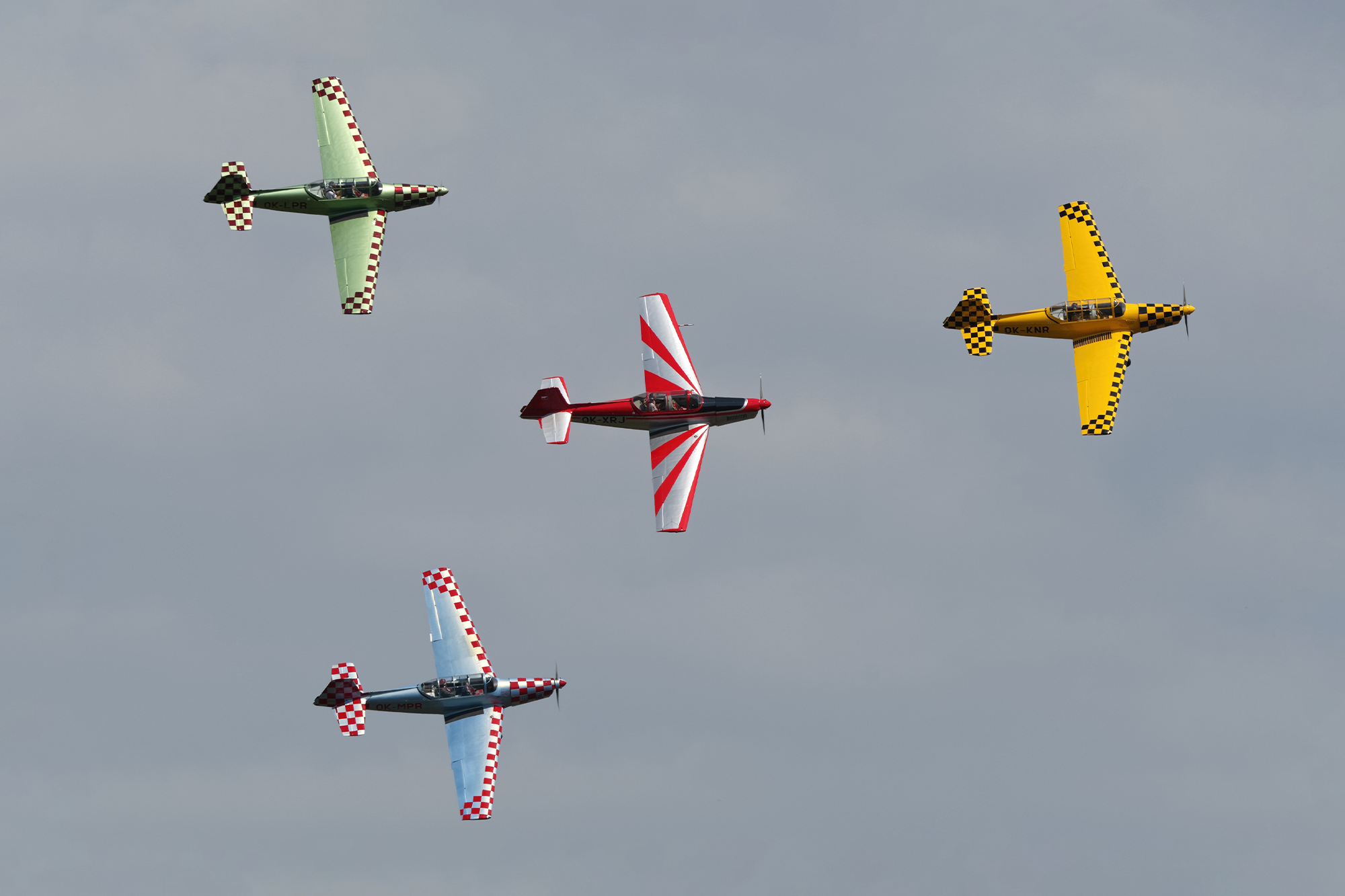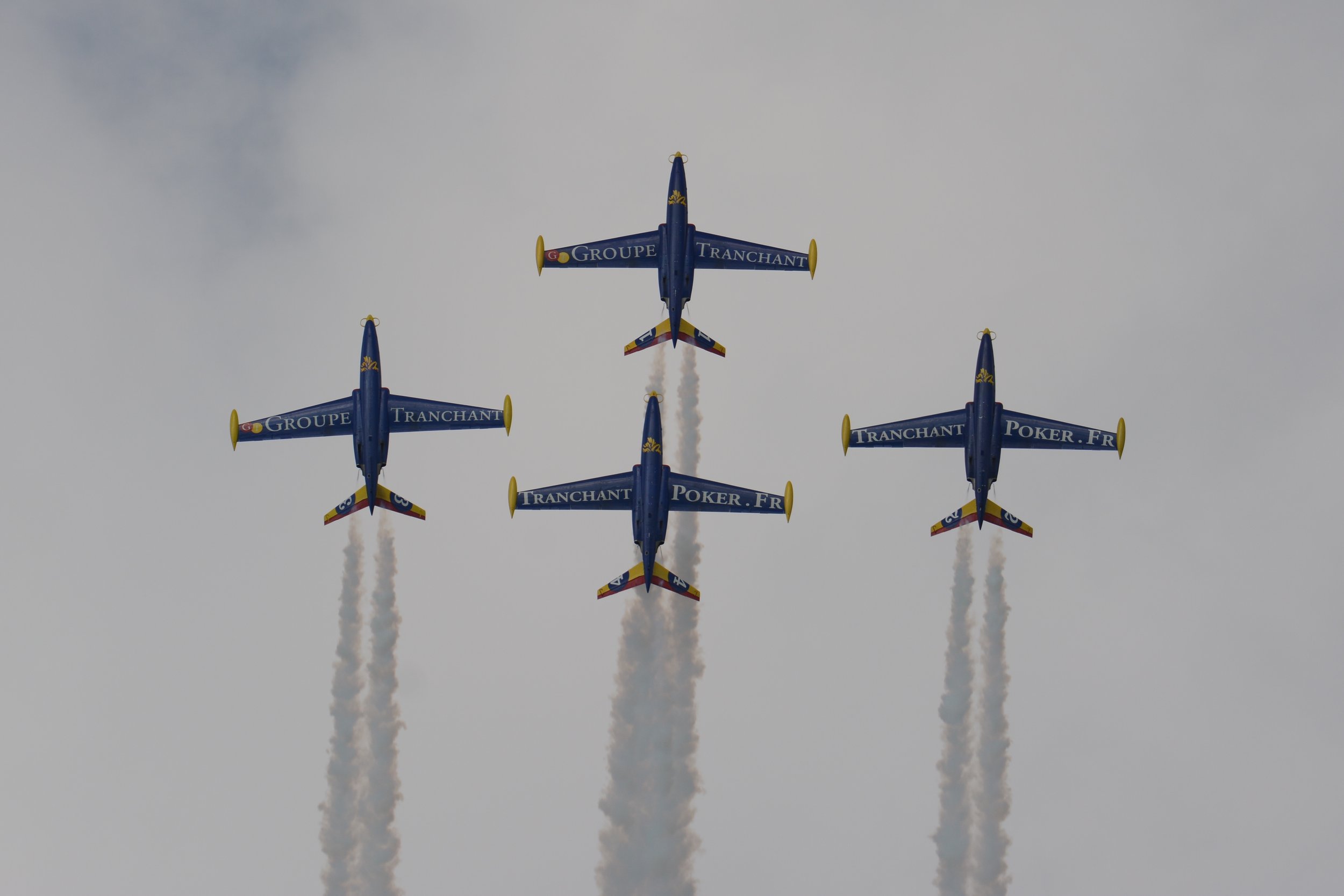Fly and Fun / Fox 2
Country
France
Size
2 or 3 Aircraft
Base
Reims - Prunay Aerodrome
The Fly & Fun Fox 2 is a renowned French Civilian Aerobatic team stationed at Prunay Aerodrome, strategically located just 10 kilometres east-southeast of Reims, in proximity to Prunay. Initially known as the Patrouille Sparflex, this aerobatic team originated in 2014 under the guidance of Michel Soutiran, the esteemed CEO of Sparflex - a prominent packaging company headquartered in France. The team showcases their skills predominantly using two or three Czechoslovakian Aero L-39 Albatros high-performance jet trainers built by Aero Vodochody. In 2021, the team for the first time performed as a coordinated formation of three aircraft. The team's riveting performance typically spans about 10 minutes, encompassing a remarkable exhibition of precise close-formation aerobatics, captivating breaks, and engaging solo displays.
| Back to Top |
Aero L-39C Albatros
The Aero L-39 Albatros is a high-performance jet trainer developed in Czechoslovakia by Aero Vodochody. It was designed during the 1960s as a replacement for the Aero L-29 Delfín as a principal training aircraft. It was the first trainer aircraft to be equipped with a turbofan powerplant. The type was exported to a wide range of countries as a military trainer.
The L-39 Albatros later served as the basis for the updated L-59 Super Albatros, as well as the L-139. A further development of the design, designated as the L-159 ALCA, entered production in 1997. To date, more than 2,800 L-39s have served with over 30 air forces around the world. The Albatros is the most widely used jet trainer in the world; in addition to performing basic and advanced pilot training, it has also flown combat missions in a light-attack role. The design never received a NATO reporting name.
At the Farnborough Airshow in July 2014, Aero Vodochody announced the launch of the L-39NG, an upgraded and modernised version of the L-39.
The L-39 Albatros was designed to be a cost-effective jet-powered trainer aircraft, which is also capable of performing ground attack missions. For operational flexibility, simplicity, and affordability, the majority of onboard systems have been simplified to avoid incurring high levels of maintenance, as well as to minimize damage caused by mishandling when flown by inexperienced aircrew. It could be readily flown from austere airstrips such as frozen lakebeds, enabled through the rugged design of the landing gear and favourable low landing speeds. The aircraft's flying qualities are reportedly simple, which is made easier by way of rapid throttle response, making it easier for students who had never previously flown a jet aircraft before to successfully control. As a training platform, the L-39 itself comprised part of a comprehensive system that also used flight simulators and mobile ground test equipment.
The low-set, straight wing has a double-taper planform, 2½-deg dihedral from the roots, a relatively low aspect ratio, and 100 litres fuel tanks permanently attached to the wingtips. The trailing edge has double-slotted trailing edge flaps inboard of mass-balanced ailerons; the flaps are separated from the ailerons by small wing fences. An automatic trimming system was present, the flaps and the trim system being connected in order to counteract the potentially large pitch changes that would otherwise be generated by vigorous movements of the flaps. The tall swept vertical tail has an inset rudder. Variable-incidence horizontal stabilizers with inset elevators are mounted at the base of the rudder and over the exhaust nozzle. Side-by-side airbrakes are located under the fuselage ahead of the wing's leading edge. The flaps, landing gear, wheel brakes and air brakes are powered by a hydraulic system. Controls are pushrod-actuated and have electrically powered servo tabs on the ailerons and rudder. Operational g-force limits at 4,200 kilograms are +8/-4 g.
A long, pointed nose leads back to the tandem cockpit, in which the student and instructor sit on Czech-built VS-1 ejection seats under individual canopies, which are opened manually and are hinged on the right. The rear seat, typically used by the instructor, is elevated slightly to readily enable observation and guidance of the student's actions in the forward position. The design of the cockpit, panel layout and many of its fittings resemble or are identical in function to those of other commonly-used Soviet aircraft; for example, the procedure for deploying the ejection seat is exactly the same as for the Mikoyan MiG-29. The cockpit is highly pressurized, requiring the aircrew to wear oxygen masks only when flying in excess of 23,000 feet. A gyro gunsight for weapon-aiming purposes is typically present in the forward position only.
A single turbofan engine, an Ivchenko AI-25TL (made in the Soviet Union) is positioned in the rear fuselage, fed through shoulder-mounted, semi-circular air intakes (fitted with splitter plates) just behind the cockpit and the tailpipe below the horizontal tailplane. The engine has a time between overhaul of 1,000 flight hours; however, it is allegedly cheaper than the majority of turbine engines to overhaul. Five rubber bag fuel tanks are located in the fuselage behind the cockpit. Several heavy radio units are typically installed in an aft avionics bay; these are often removed on civilian-operated aircraft and replaced with a 70-gallon fuel tank. Additional fuel tanks can be fitted in the rear cockpit position and externally underneath the wings; the tip tanks can also be expanded for a greater fuel capacity.
The aircraft is fitted with a hydraulically-actuated retractable nosewheel undercarriage which is designed to allow operation from grass airfields. The main landing gear legs retract inward into wing bays while the nose gear retracts forward. The basic L-39C trainer has provision for two underwing pylons for drop tanks or practice weapons, but these are not usually fitted. It can be armed with a pair of K-13 missiles to provide a basic air defence capability. Light-attack variants have four underwing hardpoints for ground attack stores, while the ZA variant also has an under-fuselage gun pod. Mock UB-16 rocket pods can also be installed for visual appearance only.
| Back to Top |












| Back to Top |

































